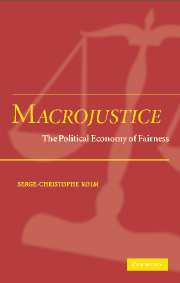Book contents
- Frontmatter
- Contents
- Presentation
- PART ONE BASES: CONSENSUS, FREEDOMS, AND CAPACITIES
- PART TWO OVERALL DISTRIBUTIVE JUSTICE: ELIE (EQUAL LABOUR INCOME EQUALIZATION)
- 7 Equal labour income equalization: General presentation
- 8 Models of labour and productivity
- 9 Equal duration income equalization
- 10 Information
- 11 Income justice
- 12 General equal labour income equalization: The model
- 13 Involuntary unemployment
- PART THREE COMPARISONS WITH POLICIES AND PHILOSOPHIES
- PART FOUR THE DEGREE OF COMMUNITY, EQUALITY, RECIPROCITY, AND SOLIDARITY
- PART FIVE COMPARISON WITH ECONOMICS' SOCIAL ETHICS
- References and bibliography
- Index
8 - Models of labour and productivity
Published online by Cambridge University Press: 31 July 2009
- Frontmatter
- Contents
- Presentation
- PART ONE BASES: CONSENSUS, FREEDOMS, AND CAPACITIES
- PART TWO OVERALL DISTRIBUTIVE JUSTICE: ELIE (EQUAL LABOUR INCOME EQUALIZATION)
- 7 Equal labour income equalization: General presentation
- 8 Models of labour and productivity
- 9 Equal duration income equalization
- 10 Information
- 11 Income justice
- 12 General equal labour income equalization: The model
- 13 Involuntary unemployment
- PART THREE COMPARISONS WITH POLICIES AND PHILOSOPHIES
- PART FOUR THE DEGREE OF COMMUNITY, EQUALITY, RECIPROCITY, AND SOLIDARITY
- PART FIVE COMPARISON WITH ECONOMICS' SOCIAL ETHICS
- References and bibliography
- Index
Summary
MODELING LABOUR
Characteristics and capacities
Equal labour income equalization can be presented with more or less complex (and complete) or simple models of the economy. Simple models may provide good descriptions, or sufficient approximations, in a number of cases. They can also be useful for focusing the presentation and discussion on crucial properties, or for didactic or illustrative purposes. The crucial issues will be the description of labour, the structure of individuals' production function showing earnings as a function of labour, and the situation of the labour market (notably, the absence or presence of involuntary unemployment). The present chapter focuses on the question of the description of labour and of the structure of the production function. It thus constitutes a preliminary for the following chapters that use its conclusions. It contains no ethical consideration – and hence, can possibly be skipped at first reading. However, its considerations are necessary for justifying formulations of labour that are usual, or that are used in the following chapters. For instance, can one speak of a “quantity of labour” or an “amount of labour”? What does this mean? What does an expression such as “she works twice as much” mean? If labour is measured by its duration, these expressions can make sense. One can then easily introduce the consideration of the speed of labour, all the rest remaining the same (if that is possible).
- Type
- Chapter
- Information
- MacrojusticeThe Political Economy of Fairness, pp. 135 - 143Publisher: Cambridge University PressPrint publication year: 2004



